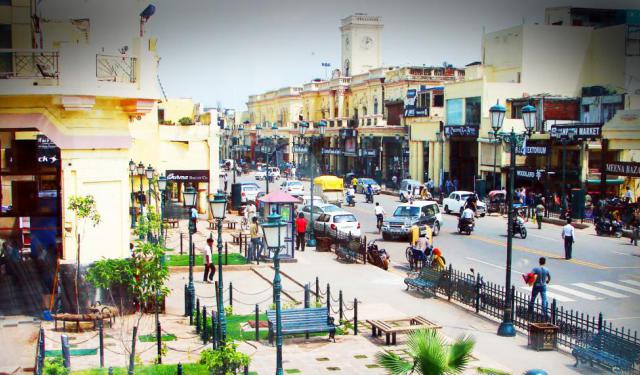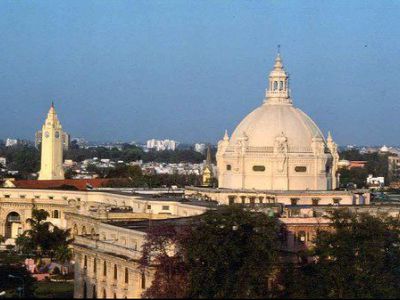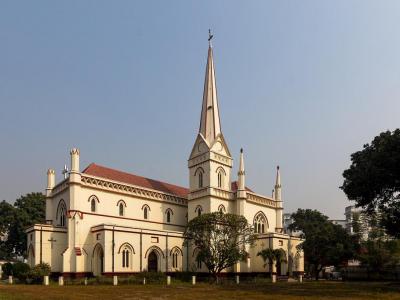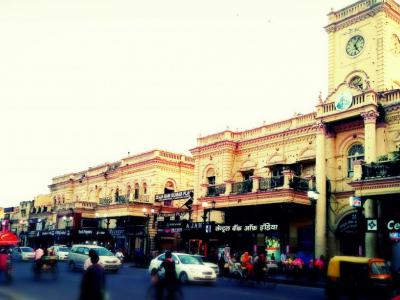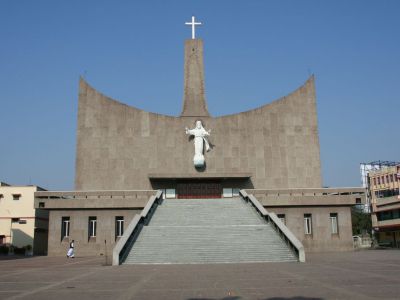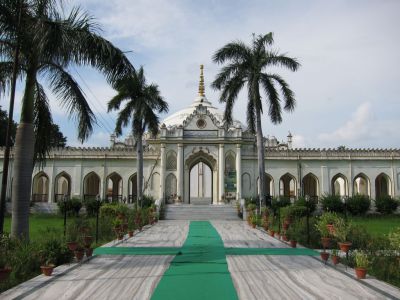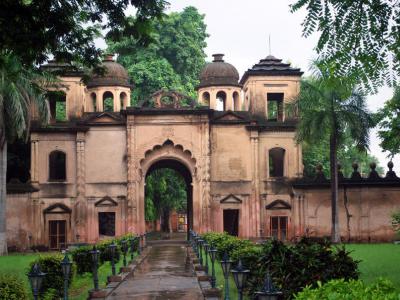Lucknow Hazratganj Walking Tour (Self Guided), Lucknow
Colloquially referred to as the heart of Lucknow, Hazratganj is the city's central shopping area with numerous malls, showrooms, bazaars, restaurants, hotels, theaters and cafés, as well as governmental offices. Apart from being a paradise for shoppers, it is also a fusion of old and modern architecture, featuring piazzas, green areas with benches and fountains, and wrought-iron and cast-iron lamp-posts flanking the sides of the walkways, reminiscent of the Victorian era.
Hazratganj got its name in 1842, after Nawab Amjad Ali Shah, whose alias was 'Hazrat', and is currently popularly known as ‘Ganj’. After the First War of Independence in 1857, the British took over the city and Hazratganj was modeled after Queen Street in London, with many old Mughal-style buildings demolished and new European structures raised in their place.
In 2010-2011, after nearly 200 years, the neighborhood received a major makeover, during which the buildings were painted in a uniform color. Also, to enhance the architecture, the beautification process involved the construction of stone pavements and Victorian-style balustrades.
Presently, the area is replete with wonderful tourist sights that are certainly worth seeing. Among them are the Uttar Pradesh Vidhan Sabha (Legislative Assembly Building), the Christ Church built as a memorial to the Indian Rebellion victims in the second half of the 19th century, and, of course, the Hazratganj Market.
Other definite must-sees include St. Joseph's Cathedral Church, the biggest church in Lucknow, and Shah Najaf Imambara, a beautiful white-domed palace on the right bank of the Gomti River.
For a closer acquaintance with Hazratganj and its delights, take this self-guided walking tour.
Hazratganj got its name in 1842, after Nawab Amjad Ali Shah, whose alias was 'Hazrat', and is currently popularly known as ‘Ganj’. After the First War of Independence in 1857, the British took over the city and Hazratganj was modeled after Queen Street in London, with many old Mughal-style buildings demolished and new European structures raised in their place.
In 2010-2011, after nearly 200 years, the neighborhood received a major makeover, during which the buildings were painted in a uniform color. Also, to enhance the architecture, the beautification process involved the construction of stone pavements and Victorian-style balustrades.
Presently, the area is replete with wonderful tourist sights that are certainly worth seeing. Among them are the Uttar Pradesh Vidhan Sabha (Legislative Assembly Building), the Christ Church built as a memorial to the Indian Rebellion victims in the second half of the 19th century, and, of course, the Hazratganj Market.
Other definite must-sees include St. Joseph's Cathedral Church, the biggest church in Lucknow, and Shah Najaf Imambara, a beautiful white-domed palace on the right bank of the Gomti River.
For a closer acquaintance with Hazratganj and its delights, take this self-guided walking tour.
How it works: Download the app "GPSmyCity: Walks in 1K+ Cities" from Apple App Store or Google Play Store to your mobile phone or tablet. The app turns your mobile device into a personal tour guide and its built-in GPS navigation functions guide you from one tour stop to next. The app works offline, so no data plan is needed when traveling abroad.
Lucknow Hazratganj Walking Tour Map
Guide Name: Lucknow Hazratganj Walking Tour
Guide Location: India » Lucknow (See other walking tours in Lucknow)
Guide Type: Self-guided Walking Tour (Sightseeing)
# of Attractions: 6
Tour Duration: 1 Hour(s)
Travel Distance: 2.9 Km or 1.8 Miles
Author: DanaOffice
Sight(s) Featured in This Guide:
Guide Location: India » Lucknow (See other walking tours in Lucknow)
Guide Type: Self-guided Walking Tour (Sightseeing)
# of Attractions: 6
Tour Duration: 1 Hour(s)
Travel Distance: 2.9 Km or 1.8 Miles
Author: DanaOffice
Sight(s) Featured in This Guide:
- Uttar Pradesh Vidhan Sabha (Legislative Assembly Building)
- Christ Church
- Hazratganj Market
- St. Joseph's Cathedral Church
- Shah Najaf Imambara
- Sikandar Bagh Villa
1) Uttar Pradesh Vidhan Sabha (Legislative Assembly Building)
Thye Legislative Assembly Building-home to the state’s Legislative Assembly and Council-is an imposing symbol of Indo‑European architectural finesse and political heritage. The foundation stone of the building was laid by Governor Sir Spencer Harcourt Butler on December 15, 1922, and it was inaugurated on February 21, 1928, after more than five years of construction.
Designed by Sir Samuel Swinton Jacob and Sri Heera Singh, this majestic marble and sandstone structure is built from light brown Mirzapur sandstone, with interior features adorned in marble from Agra and Jaipur. The building’s central octagonal hall boasts a soaring domed roof, flanked on both sides by circular marble staircases, decorative arches, and painted walls.
While access inside may require permission or special arrangement, its exterior garners appreciation for its architectural significance and historical importance. Beyond its aesthetic merit, the Vidhan Bhavan is an active seat of governance, hosting all sessions of the legislature-including budget, monsoon, and winter sittings-where elected members debate policies for Uttar Pradesh’s residents.
Designed by Sir Samuel Swinton Jacob and Sri Heera Singh, this majestic marble and sandstone structure is built from light brown Mirzapur sandstone, with interior features adorned in marble from Agra and Jaipur. The building’s central octagonal hall boasts a soaring domed roof, flanked on both sides by circular marble staircases, decorative arches, and painted walls.
While access inside may require permission or special arrangement, its exterior garners appreciation for its architectural significance and historical importance. Beyond its aesthetic merit, the Vidhan Bhavan is an active seat of governance, hosting all sessions of the legislature-including budget, monsoon, and winter sittings-where elected members debate policies for Uttar Pradesh’s residents.
2) Christ Church
The Christ Church stands as a timeless memorial to the souls lost during the Indian Rebellion of 1857. Consecrated on 26 November 1860 by Bishop Cotton, the church was originally known as the Church of England and was designed by General Hutchinson of the Royal Engineers. It is recognized as the first English church in North India and the third in the subcontinent.
A graceful example of Victorian Neo-Gothic architecture, the building’s cruciform layout-transepts jutting out as arms and a chancel forming the head-creates both symbolic and visual impact. The elegant façade, rising into a lofty bell tower topped with a slender spire and topped by a slightly twisted cross, a relic of a 1933 earthquake, adds a stately presence to the cityscape.
The interior walls are lined with marble tablets and polished brass plaques commemorating British soldiers, clergy, and civilians killed during the 1857 siege-among them General James Grant Thomson and Reverend Henry Polehampton. Two stained-glass murals, especially the large winged pane above the altar, lend a delicate touch of light and artistry to the otherwise subdued interior.
In the present day, Christ Church continues to function as a house of worship and also shares its grounds with Christ Church College, an Anglo-Indian school established in 1878. The site remains open to visitors, with free entry and permission for photography.
A graceful example of Victorian Neo-Gothic architecture, the building’s cruciform layout-transepts jutting out as arms and a chancel forming the head-creates both symbolic and visual impact. The elegant façade, rising into a lofty bell tower topped with a slender spire and topped by a slightly twisted cross, a relic of a 1933 earthquake, adds a stately presence to the cityscape.
The interior walls are lined with marble tablets and polished brass plaques commemorating British soldiers, clergy, and civilians killed during the 1857 siege-among them General James Grant Thomson and Reverend Henry Polehampton. Two stained-glass murals, especially the large winged pane above the altar, lend a delicate touch of light and artistry to the otherwise subdued interior.
In the present day, Christ Church continues to function as a house of worship and also shares its grounds with Christ Church College, an Anglo-Indian school established in 1878. The site remains open to visitors, with free entry and permission for photography.
3) Hazratganj Market (must see)
In 1827 the ruler Nasir-ud-Din Haldar Shah founded what was to become the Ganj market. He opened a Bazaar selling merchandise from China, Japan, and Belgium. In 1842, the shopping area's name was changed to Hazratganj, in honor of the ruler Amjad Aji Shah, known by his nickname "Hazrat."
After the First War of Independence ended in 1857, Lucknow was totally under British occupation. The Hazratganj was modified into a version of London's Queen Street. Mughal-style structures were demolished and replaced with European-style buildings.
The term "ganj" implies strolling along and shopping. Like Connaught Place in New Delhi, Hazratganj is a major shopping district in the city. Car dealerships, jewelry, antiques, books, food, and anything is available at Hazratganj. In 2010, the Market was transformed into a Victorian-style area with lighting, benches, and fountains.
Buildings in the Ganj are both new and old. Some housing shops, restaurants, and cinemas are almost 200 years old. Among the landmarks of Lucknow to be found in Hazratganj are the Mayfair Cinema, the British Council Library, the Lucknow Coffee House, and the Ram Advent Bookshop.
The Ganj is a place for malls. The most popular are Sahara Ganj, City Life, Lucknow-Riverside, Fun Republic, Umrao, City Mall, Wave Mall, and Singapore Mall. Have a lunch break with the rich Lucknowi cuisine at the Royal Cafe. JJ Bakers is dessert heaven. The Cherry Tree Cafe is great for snacks.
Showrooms, shopping complexes, restaurants, hotels, cafes, theaters, and malls abound. And let us not forget the monthly Carnival. On the second Sunday of each month, the Lucknow Development Authority sponsors a carnival in Hazratganj. The Market becomes a vast no-parking zone given over the public entertainment and cultural programs.
After the First War of Independence ended in 1857, Lucknow was totally under British occupation. The Hazratganj was modified into a version of London's Queen Street. Mughal-style structures were demolished and replaced with European-style buildings.
The term "ganj" implies strolling along and shopping. Like Connaught Place in New Delhi, Hazratganj is a major shopping district in the city. Car dealerships, jewelry, antiques, books, food, and anything is available at Hazratganj. In 2010, the Market was transformed into a Victorian-style area with lighting, benches, and fountains.
Buildings in the Ganj are both new and old. Some housing shops, restaurants, and cinemas are almost 200 years old. Among the landmarks of Lucknow to be found in Hazratganj are the Mayfair Cinema, the British Council Library, the Lucknow Coffee House, and the Ram Advent Bookshop.
The Ganj is a place for malls. The most popular are Sahara Ganj, City Life, Lucknow-Riverside, Fun Republic, Umrao, City Mall, Wave Mall, and Singapore Mall. Have a lunch break with the rich Lucknowi cuisine at the Royal Cafe. JJ Bakers is dessert heaven. The Cherry Tree Cafe is great for snacks.
Showrooms, shopping complexes, restaurants, hotels, cafes, theaters, and malls abound. And let us not forget the monthly Carnival. On the second Sunday of each month, the Lucknow Development Authority sponsors a carnival in Hazratganj. The Market becomes a vast no-parking zone given over the public entertainment and cultural programs.
4) St. Joseph's Cathedral Church
Saint Joseph’s Cathedral Church offers visitors a retreat amid one of the city’s liveliest areas. Built in 1860 under the guidance of the Irish priest Rev. Fr. William Gleeson and completed in 1862, the cathedral was blessed by Bishop Anastasius Hartmann shortly thereafter, making it one of the oldest Catholic churches in Uttar Pradesh.
The architecture of Saint Joseph’s Cathedral is modern, standing out from more traditional church designs in India. The upper façade is shaped like a giant crescent crowned by a tall column and topped with a imposing cross. At its center is a large statue of Jesus Christ with outstretched arms welcoming visitors. Inside, the first-floor prayer hall is spacious, with pews aligned and stained-glass windows.
For many, the most enchanting time to experience Saint Joseph’s Cathedral is during Christmas. The church is festively illuminated, nativity scenes are artfully displayed, and the choir fills the air with carols.
The architecture of Saint Joseph’s Cathedral is modern, standing out from more traditional church designs in India. The upper façade is shaped like a giant crescent crowned by a tall column and topped with a imposing cross. At its center is a large statue of Jesus Christ with outstretched arms welcoming visitors. Inside, the first-floor prayer hall is spacious, with pews aligned and stained-glass windows.
For many, the most enchanting time to experience Saint Joseph’s Cathedral is during Christmas. The church is festively illuminated, nativity scenes are artfully displayed, and the choir fills the air with carols.
5) Shah Najaf Imambara
Shah Najaf Imambara was built circa 1816–1818 by Nawab Ghazi‑ud‑Din Haider, the last Nawab Wazir and first King of Awadh, it serves as the mausoleum for himself and his three wives, each resting under ornate silver and gold tombs. The structure was named in reverence to Hazrat Ali, also known as Shah‑e‑Najaf, and is thought to mirror his shrine in Najaf, Iraq.
The Shah Najaf Imambara displays a refined simplicity, marked by its whitewashed dome and understated Mughal elements. Its dome stands out for its broad, flattened form instead of the usual tall, onion-shaped profile, including two identical gateways. Approaching the building, visitors pass through a lush garden that opens into the main prayer space and tomb chamber, situated beneath a central hall decorated with hanging chandeliers.
Having served as a defensive stronghold during the 1857 Siege of Lucknow. Its robust walls withstood heavy cannon fire during the British offensive famously referred to as the “Storming of the Shah Najaf.” Today, however, the atmosphere is one of quiet reverence-particularly during special occasions like Hazrat Ali’s birth anniversary or the reflective rituals of Muharram.
The Shah Najaf Imambara displays a refined simplicity, marked by its whitewashed dome and understated Mughal elements. Its dome stands out for its broad, flattened form instead of the usual tall, onion-shaped profile, including two identical gateways. Approaching the building, visitors pass through a lush garden that opens into the main prayer space and tomb chamber, situated beneath a central hall decorated with hanging chandeliers.
Having served as a defensive stronghold during the 1857 Siege of Lucknow. Its robust walls withstood heavy cannon fire during the British offensive famously referred to as the “Storming of the Shah Najaf.” Today, however, the atmosphere is one of quiet reverence-particularly during special occasions like Hazrat Ali’s birth anniversary or the reflective rituals of Muharram.
6) Sikandar Bagh Villa
Originally conceived as a lush royal retreat by Nawab Saadat Ali Khan around 1800, Sikandar Bagh Villa was significantly enhanced in the early 19th century by the last Nawab of Awadh, who dedicated the property to his beloved Sikandar Mahal Begum. Spanning roughly 4.5 acres, the site blended Mughal and Awadhi aesthetics-highlighted by an enclosed garden, fortified walls, bastions, an elegant gateway adorned with fish motifs, and a central pavilion that once hosted Ras-lila performances, Kathak dances, music, and poetic mehfils.
Tragically, the villa’s romantic legacy was overshadowed during the Indian Rebellion of 1857, when Sikandar Bagh became a stronghold for nearly 2,000 mutinous sepoys defending against British forces. On 16 November 1857, British troops stormed the garden under Sir Colin Campbell’s command, resulting in massive casualties within its walls. One of the most poignant stories from the battle tells of Uda Devi, a female warrior who is said to have fired at British soldiers from atop a tree until she was fatally wounded-today, her memory is honored by a statue near the premises.
Today, the site is maintained by the Archaeological Survey of India and serves as part of the National Botanical Research Institute. Visitors can explore remnants of the original walls, cannonball scars, and recovered artifacts such as muskets, swords, and ammunition, now displayed in the institute’s exhibition. Although much of the original palace architecture is lost, the main gateway and small pavilion remain evocative of the garden’s bygone grandeur.
Tragically, the villa’s romantic legacy was overshadowed during the Indian Rebellion of 1857, when Sikandar Bagh became a stronghold for nearly 2,000 mutinous sepoys defending against British forces. On 16 November 1857, British troops stormed the garden under Sir Colin Campbell’s command, resulting in massive casualties within its walls. One of the most poignant stories from the battle tells of Uda Devi, a female warrior who is said to have fired at British soldiers from atop a tree until she was fatally wounded-today, her memory is honored by a statue near the premises.
Today, the site is maintained by the Archaeological Survey of India and serves as part of the National Botanical Research Institute. Visitors can explore remnants of the original walls, cannonball scars, and recovered artifacts such as muskets, swords, and ammunition, now displayed in the institute’s exhibition. Although much of the original palace architecture is lost, the main gateway and small pavilion remain evocative of the garden’s bygone grandeur.
Walking Tours in Lucknow, India
Create Your Own Walk in Lucknow
Creating your own self-guided walk in Lucknow is easy and fun. Choose the city attractions that you want to see and a walk route map will be created just for you. You can even set your hotel as the start point of the walk.
Lucknow Introduction Walking Tour
The capital city of the Indian state of Uttar Pradesh, Lucknow, is one of the country's most popular tourist destinations. It owes its popularity largely to the rich architectural, cultural and historic heritage.
In the 14th century, Lucknow was the capital of the Awadh region. Starting from 1350, both the city and some parts of the region were controlled consecutively by the Delhi... view more
Tour Duration: 3 Hour(s)
Travel Distance: 4.0 Km or 2.5 Miles
In the 14th century, Lucknow was the capital of the Awadh region. Starting from 1350, both the city and some parts of the region were controlled consecutively by the Delhi... view more
Tour Duration: 3 Hour(s)
Travel Distance: 4.0 Km or 2.5 Miles
The Most Popular Cities
/ view all
